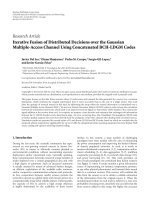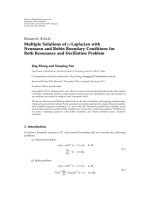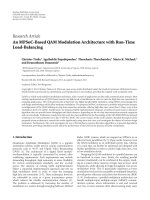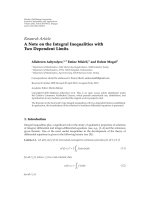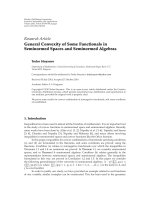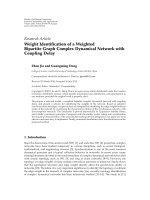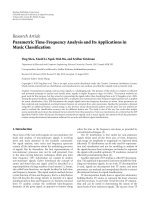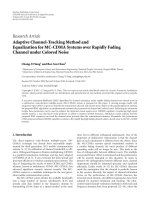Báo cáo hóa học: " Research Article Multiple Human Tracking Using Particle Filter with Gaussian Process Dynamical Model" pdf
Bạn đang xem bản rút gọn của tài liệu. Xem và tải ngay bản đầy đủ của tài liệu tại đây (13.49 MB, 10 trang )
Hindawi Publishing Corporation
EURASIP Journal on Image and Video Processing
Volume 2008, Article ID 969456, 10 pages
doi:10.1155/2008/969456
Research Article
Multiple Human Tracking Using Particle Filter with
Gaussian Process Dynamical Model
Jing Wang, Yafeng Yin, and Hong Man
Department of Electrical and Computer Engineering, School of Engineering and Science, Stevens Institute of Technology,
Hoboken, NJ 07030, USA
Correspondence should be addressed to Jing Wang,
Received 1 March 2008; Revised 23 July 2008; Accepted 14 October 2008
Recommended by Stefano Tubaro
We present a particle filter-based multitarget tracking method incorporating Gaussian process dynamical model (GPDM) to
improve robustness in multitarget tracking. With the particle filter Gaussian process dynamical model (PFGPDM), a high-
dimensional target trajectory dataset of the observation space is projected to a low-dimensional latent space in a nonlinear
probabilistic manner, which will then be used to classify object trajectories, predict the next motion state, and provide Gaussian
process dynamical samples for the particle filter. In addition, Histogram-Bhattacharyya, GMM Kullback-Leibler, and the rotation
invariant appearance models are employed, respectively, and compared in the particle filter as complimentary features to
coordinate data used in GPDM. The simulation results demonstrate that the approach can track more than four targets with
reasonable runtime overhead and performance. In addition, it can successfully deal with occasional missing frames and temporary
occlusion.
Copyright © 2008 Jing Wang et al. This is an open access article distributed under the Creative Commons Attribution License,
which permits unrestricted use, distribution, and reproduction in any medium, provided the original work is properly cited.
1. INTRODUCTION
Multitarget tracking is an important issue in security
applications, which have attracted considerable attention
and interest in recent years. Some classical approaches to
multitarget tracking include the multiple hypothesis tracker
(MHT) and the joint probabilistic data association filter
(JPDAF) [1]. Particle filters have been recently used for
multitarget tracking tasks, because they can deal with inde-
terministic motions, as well as nonlinear and non-Gaussian
systems. However, joint particle filters can normally track
up to three or four identical objects due to the exponential
complexity [2]. A possible solution to this problem is
to integrate the Gaussian process dynamical prediction
function with the learning mechanism, which provides a
particle filter with prior information to reduce sampling
ambiguity, and improve particle efficiency. Furthermore, the
high-dimensional learning datasets may increase classifica-
tion and computation complexities. This can be alleviated
by dimension reduction through nonlinear mapping, and
incorporating Markov dynamics in the low-dimensional
latent space for data prediction. Our major contribution
in this work is a novel multitarget tracking algorithm that
incorporates particle filters with Gaussian process dynamical
model to improve tracking accuracy and computational
efficiency. Initial tests indicate that target objects (e.g.,
people) in a specific environment may have similar trajectory
patterns, which make potentially efficient tracking algorithm
possible. We use trajectory classification instead of pose
and motion classification in motion tracking, therefore state
sharing can be achieved on the latent space to take advantage
of similar object trajectory properties. In addition, our
research focuses on efficient multitarget trajectory tracking
as well as handling missing frames and temporary occlusions
to produce reliable tracking results for high-level analysis.
This article is organized as follows. Section 2 reviews
previous work on tracking by using particle filter and Gaus-
sian process dynamical model. The proposed particle filter
Gaussian process dynamical model is described in Section 3.
In Section 4, the experimental results are presented, and the
articleissummarizedinSection 5.
2. PREVIOUS WORK
Thepreviousworkissummarizedasfollows.Khanetal.
proposed a template-based particle filter system to track
2 EURASIP Journal on Image and Video Processing
interacting ants [1]. Compared with people, ants are more
rotation invariant and have less contour changes, hence the
learning system should be different. Okuma et al. studied
multiple hockey players detecting and tracking by deploying
particle filter incorporating Ada boost detection proposal
generation algorithm [2].TheKernelparticlefilterwas
developed to track multiple targets in image sequences by
Chang et al. [3]. Zhou et al. proposed a particle filter-
based tracking system with an appearance-adaptive model
[4].
A trans-dimensional Markov Chain Monte Carlo
(MCMC) particle filter was proposed for reliable tracking
of indefinite number of interacting targets [5]. Multiple
objects are formulated by a joint state-space model
while efficient sampling is performed by deploying
trans-dimensional MCMC on the subspace. It failed to
track some targets due to the weakness of color models.
Reference [6] employed particle filter to handle partial
occlusion as a component of a proposed Hybrid Joint-
Separable (HJS) filter framework in multibody tracking.
A mean field Monte Carlo (MFMC), that is, particle filter
modeled as a competition problem was used to address
coalescence issue occurred in multitarget tracking [7].
Reference [8] employed particle filter incorporating with
a multiblob likelihood function to track unknown and
varied objects while assuming background modeling
is effective given a static camera. A color particle filer
embedded with a detection algorithm was proposed by
[9] to track multiple targets deploying the same color
description with internal initialization and cancelation
functionality.
Gaussian process latent variable model described by
Neil Lawrence handles probabilistic nonlinear dimension-
ality reduction problems to model the high-dimensional
observation data and the corresponding projections onto the
low-dimensional latent space [10]. Wang et al. incorporate
Markov dynamics on latent variable state transitions lending
Gaussian process latent variable model to handle time series
data and robustly track human body motion and pose
changes by classifying poses and motions [11]. Reference
[12]usedGPDMtotrack3Dhumanposeandmotion.
Raskin et al. proposed a Gaussian process annealing particle
filter-based method to perform 3D target tracking by explor-
ing color histogram features [13]. Our research is different
in that multitarget trajectory tracking was performed, whilst
the annealing particle filter GPDM framework proposed by
Raskin et al. tracked 3D pose and motion of one target. In
addition, our particle generation mechanism and classified
elements are different.
Reference [14] described a framework combining
the particle filter, GPDM, and discriminative learning
approaches to avoid 3D human model in tracking 3D
human motion. Image latent space mapping on joint angle
latent space is performed by employing relevance vector
machine (RVM) on small training sets. Reference [15]
proposed a shared latent dynamical model derived from
GPLVM and GPDM to diminish the dimensionality of
the pose state space, hence facilitate the manipulation of
tracking data. The latent space can be projected to both
state space and observation space by learning approach
with dynamic mechanism. SLDM is integrated with con-
densation framework to estimate positions in the latent
space and reconstruct human poses. Reference [16]pre-
sented a full-3D edge tracker by using particle filter to
track complex 3D objects of flexible motion and under
self-occlusions with hidden line removal capability. Real-
time rate is obtained by employing accelerating hardware
implementation on hidden line removal and likelihood
calculation.
3. PARTICLE FILTER GAUSSIAN DYNAMICAL PROCESS
3.1. Particle filter and GPDM
A particle filter is a Monte Carlo method for nonlinear, non-
Gaussian models, which approximates continuous proba-
bility density function by using large number of samples.
Hence, the accuracy of the approximation depends on high-
dimensional state space which causes exponential increase
of the number of particles. Given the time complexity
constraint, the reduction of particles, and hence the compu-
tation power is a potential solution.
In GPDM, an observation space vector represents a pose
configuration and motion trajectory captured by a sequence
of poses. At the beginning of the learning procedure, the
target data from observation is projected to a subspace-
latent space by principal components analysis (PCA). During
this projection, with an assumption of Gaussian prior
distribution over the latent space, the projection will become
a nonlinearization through Gaussian process, so it can be
viewed as probability PCA (PPCA) [17]. Then, scaled conju-
gated gradient (SCG) is applied to optimize and smooth the
initialized coordinates. Once a GPDM is created, sampling
from the dynamical field provides meaningful prediction
on the future motion changes. The latent space defines
the temporal dependence between poses by employing
Gaussian process integrated by Markov chain on the latent
variable transitions. Since motion prediction, the temporal
dependence, and sampling are performed on the latent space,
potential computation benefits may be obtained.
3.2. Particle filter Gaussian process dynamical model
This research aims at developing a low-complexity and
highly-efficient algorithm for tracking variable number of
targets with competitive tracking performance in term of
accuracy. With the general framework of GPDM, it can
be extended to estimate pose and motion changes as
proposed by Wang et al. Hence, if a target is suspected of
malicious behavior, the system can trade performance off
time complexity.
The basic procedure of the proposed particle filter
Gaussian process is as follows.
(1) Creating GPDM. GPDM is created on the basis of
the trajectory training data sets, that is, coordinate
difference values, and the learning model parameters
Jing Wang et al. 3
Γ ={Y
T
, X
T
, α, β, W},whereY
T
is the training
observation dataset, X
T
is the corresponding latent
variable sets,
α and β are hyperparameters, and W is
ascaleparameter.
(2) Initializing the model parameters and the parti-
cle filter. The latent variable set of the training
data and parameters
{X
T
, α, β} are obtained by
minimizing the negative log posterior function
−ln p(X
T
, α, β,W | Y
T
) of the unknown parameters
{X
T
, α, β, W} with scaled conjugate gradient (SCG)
on the training datasets.
The prior probability is derived on the basis of
the created model. In this step, target templates
are obtained from the previous frames as reference
images for similarity calculation in the later stage.
(3) Projecting from the observation space to latent space.
The test observation data is projected on the latent
coordinate system by using probabilistic principal
component analysis (PPCA). As a result, the dimen-
sionality of the observed data is reduced.
(4) Predicting and sampling. Particles are generated by
using GPDM in the latent space and the test data to
infer the likely coordinate change value (Δx
i
, Δy
i
).
(5) Determining probabilistic mapping from latent space
to observation space. The log posterior probability of
the coordinate difference values of the test data is
maximized to find the best mapping in the training
datasets of the observation space. In addition, the
most likely coordinate change value (Δx
i
, Δy
i
) is used
for predicting the next motion.
(6) Updating the weights. In the next frame, the similarity
between the template’s corresponding appearance
model and the cropped region centered on the parti-
cle is calculated to determine the weights w
i
, and the
most likely location (
x
t+1
, y
t+1
) of the corresponding
target, as well as to decide whether resampling is
necessary or not.
(7) Repeat Steps 3–6.
3.2.1. Observation space
The targets of interest are detected and tracked for trajectory
analysis. Instead of studying the coordinate values, the differ-
ences of the same target in two neighboring frames are calcu-
lated as the observed data. The location of the target can be
obtained by adding the difference to the previous coordinate
values. The 2D coordinate difference values of the head, cen-
troid, and feet form a 6-dimensional vector for each object,
given by Y
k
= (Δ(x
1
), Δ(y
1
), Δ(x
2
), Δ(y
2
), Δ(x
3
), Δ(y
3
)),
where Y
k
is the observation value of the kth target, and
(x
k
+ Δ(x
k
), y
k
+ Δ(y
k
)) is the coordinate value of the
corresponding body part. With the 3 sets of coordinate
values, the boundary, width, and height of an object can be
determined. If there are 5 targets, the observation data has 30
dimensions.
3.2.2. Establishing trajectory learning model and
obtaining appearance templates
GPDM is deployed to learn the trajectories of moving
objects. The probability density function of latent variable X
and the observation variable Y are defined by the following
equations:
P
X
k
| α
=
p(x
k
)
(2π)
(N−1)d
K
X
d
exp
−
1
2
tr
K
−1
X
X
2:N
X
T
2:N
,
(1)
where α is the hyperparameter of kernel, p(x)canbe
assumed to have Gaussian prior, N is the length of latent
vector, d is the dimension of latent space, and K
X
is the kernel
matrix
P
Y
k
| X
k
=
|
W|
N
2π
ND
K
Y
D
exp
−
1
2
tr
K
−1
Y
YW
2
Y
T
,
(2)
where k is the kth target, K
Y
is the kernel function, and W is
the hyperparameter.
In our study, RBF kernel given by the following is
employed for GPDM model
k
Y
x, x
=
exp
−
γ
2
x − x
2
+ β
−1
δ
X,X
,(3)
where x and x
are any latent variables in the latent space, γ
controls the width of the kernel, and β
−1
is the variance of
the noise.
Given a specific surveillance environment, certain pat-
terns may be observed and worth exploring for future
inferences. To initialize the latent coordinate, the d (dimen-
sionality of the latent space) principal directions of the
latent coordinates is determined by deploying probabilistic
principal component analysis on the mean subtracted train-
ing dataset Y
T
, that is, Y
T
− Y
T
.GivenY
T
, the learning
parameters are estimated by minimizing the negative log
posterior using scaled conjugate gradient (SCG) [18]. SCG
was proposed to optimize the multiple parameters of large
training sets by deploying Levenberg-Marquardt approach
to avoid line search per learning iteration, which increases
calculation complexity.
Besides position training datasets, the appearance
database is created by obtaining the template images of
human head, feet, and torso from the initial frames.
3.2.3. Latent space projecting, predicting and
particle sampling
Since GPDM was constructed in the latent space, at the
beginning of the test process, the target observation data
has to be projected to the same 2-dimensional latent
space in order to be compared to the trained GPDM.
This projection is achieved by using probabilistic principal
component analysis (PPCA), same as the first stage in GPDM
learning. The feature vector of each frame contains three
4 EURASIP Journal on Image and Video Processing
pairs of coordinate change values for every target being
tracked in that frame. For n targets, the feature vector
will contain 3
× n pairs of coordinate change values. The
PPCA projection will reduce this 3
× n × 2 dimensional
featurevectortoa1
× 2latentspacevectortobeused
in particle filtering. The purpose of projecting the test data
from the observation space to the latent space is to initialize
the testing data in the latent space and obtain a compact
representation of the similar motion patterns in the training
dataset. With PPCA and trained GPDM, we can learn certain
common motion patterns (e.g., velocities, directions, etc.)
from multiple training targets, and then use the learned
latent space motion behavior to predict multiple targets’
future trajectories using particle filter with much improved
efficiency. This is based on the presumption that many
human trajectories possess similar properties in common
video surveillance applications. It should be noted that the
number of targets being tracked does not need to be identical
to that in the training data. This is possible because that
PPCA aggregates (or projects) multiple training objects as
well as test objects onto the same low-dimensional space, and
therefore the number of objects does not pose a constraint
on the tracking process. If we can obtain the templates
and the corresponding initial coordinates of n objects at
the beginning of the test phase, the proposed framework
can track these n targets regardless the number of training
targets.
Particles are generated on the basis of the Gaussian
process dynamical model in the latent space, taking the
motion model property and unpredictable motion into
consideration. The next possible position is predicted by
determining the most similar trajectory pattern in the
training database and using the corresponding position
change value plus noise. The number of particles are reduced
from over one hundred to about twenty by deriving the
posterior distribution over functions, instead of parameters,
and taking advantage of the learned knowledge. The sim-
ulation indicates that the decreasing number of particles
does not compromise the tracking results, even in temporary
occlusion cases (see Section 4). An example of the learned
GPDM space is shown in Figure 1. Each point on this 2D
latent space is a projection of a feature vector representing
two training targets, that is, 6 pairs of coordinate change
values. A total of 72 points in the figure correspond to
feature vectors of these two targets over 73-image frames.
The grayscale intensity represents the precision of mapping
from the observation space to the latent space, and the
lighter the pixel appears the higher the precision of mapping
is.
3.2.4. Mapping from latent space to observation space
Thereafter, the latent variables are mapped in a probabilistic
way to the location difference data in the observation space,
defining the active region (i.e., distribution) of an observed
target. However, the exact predicted coordinate values of the
motion trajectory in the observation space need be calculated
so that the importance weight for each particle in the
observation space can be updated. Estimation maximization
−3
−2.5
−2
−1.5
−1
−0.5
0
0.5
1
1.5
−1 −0.500.511.522.5
Run dynamics
Figure 1: Latent space projections of a 2-target training vector
sequence.
Figure 2: Construction of a rotation invariant appearance model
for feet representation.
(EM) approach is employed to determine the most likely
observation coordinates in the observation space after the
distribution is derived.
The nondecreasing log posterior probability of the test
data is given by
log
P
Y
k
| X
T
, β, W
=
log
⎛
⎜
⎜
⎝
|
W|
N
2π
ND
K
Y
D
exp
−
1
2
tr
K
−1
Y
YW
2
Y
T
⎞
⎟
⎟
⎠
,
(4)
where W is the hyperparameter, N is the number of Y
sequences, D is the data dimension of Y,andK
Y
is a
kernel matrix defined by a RBF kernel function given by
(3). The log posterior probability is maximized to search for
the most probable correspondence on the training datasets.
The corresponding trajectory pattern is then selected for
predicting the following motion. The simulation results
show that it returns better prediction results than averaging
the previous motion values. In addition, various targets
can share the same database to deal with different future
situations.
Jing Wang et al. 5
Figure 3: Sample results of tracking 5 targets using Histogram-Bhattacharya approach.
Figure 4: Sample results of tracking 5 targets using GMM-KL appearance model.
Figure 5: Sample results of tracking 2 Targets using rotation invariant appearance model.
6 EURASIP Journal on Image and Video Processing
Figure 6: Sample results of tracking targets with temporary occlusion.
Table 1: Tracking performance of PFGPDM with three appearance
models.
No. of No. of
Error rate Runtime
frames targets
Histogram-Bharttacharyya
30 2 3%
30 5 6.7%
40 5 0 120 sec
GMM-KL
30 2 0%
30 5 6.7%
40 2 2.5%
40 5 0 209 sec
Rotation invariant
30 2 0%
40 2 0%
40 5 5% 196 sec
Table 2: Comparison of three methods on number of particles and
error rates.
Algorithm
No. of No. of
Error rate
targets particles
AAMPF [4]187∼176 0
PFGPDM 1 20 0
TDMCPF [5] 4 300 0
PFGPDM 4 100 0
3.2.5. Importance weights update
The weights of the particles are updated in terms of the
likelihood estimation based on the appearance model. The
importance weight equation is given by
P
Y
t
| Z
t
, k
t
=
P
Z
t
| k
t
,
Y
t
P
k
t
,
Y
t
P
Z
t
,
w
t
∝ P
Z
t
| k
t
,
Y
t
P
k
t
,
Y
t
,
(5)
where
Y
t
is the estimation data, Z
t
is the observation data,
k
t
is the identity of the target, and w
t
is the weight of a
particle. In our study, the likelihood function P(Z
t
| k
t
,
Y
t
)
is defined to be dependent on the similarity between the
appearance model distribution of the template and that of
the test object. Therefore, the choice of appearance model is
important for updating the weights of particles. Edge feature
is not used in this study due to its ambiguity in term of
foreground and background, as well as the computation
efficiency consideration. Histogram-Bhattacharya, GMM-
KL appearance model, and rotation invariant model were
tested to determine the resulting performance and time
complexity.
3.2.6. Histogram-Bhattacharya and
GMM-KL appearance model
Histogram-Bhattacharya was used for its simplicity and
efficiency [19]. The RGB histogram of the template and the
image region under consideration are obtained, respectively.
The likelihood P(Z
t
| k
t
,
Y
t
) is defined to be proportional
to the similarity between the histogram of the template and
the candidate, that is, the region centered on the considered
particle of the same size as the template. The above-
mentioned similarity is measured by using Bhattacharya
distance, since it provides complex nonlinear correlations
between distributions.
GMM-KL frame is employed to measure the similarity
between the image of template and the test object. GMM
is a semiparametric multimodal density model consisting
of a number of components to compactly represent pixels
of image block in color space with illumination changes.
Image can be represented as a set of homogeneous regions
modeled by a mixture of Gaussian distributions in color
feature space [20]. In comparison, Histogram-Bhattacharya
framework presents an image without taking spatial factor
into computation. The Kullback-Leibler distance is a mea-
sure of the distance between two-probability distributions
given the metric of relative entropy [21]. Since the image
approximated by Gaussian mixture model can be consid-
ered as independently identically distributed (iid) samples
following Gaussian mixture distribution, comparison of the
template image to that of the test image is formulated as
measuring the distance between the two Gaussian mixture
distributions. Symmetric version and nonsymmetric version
are given by the following:
D
p
1
, p
2
∼
=
1
n
n
1
t=1
log
p
1
x
1t
p
2
x
1t
+
1
n
2
n
2
t=1
log
p
2
x
2t
p
1
x
2t
,
D
p
1
, p
2
∼
=
1
n
n
t=1
log
p
1
x
t
p
2
x
t
,
(6)
where p
1
and p
2
are Gaussian mixture distributions.
Jing Wang et al. 7
Figure 7: Sample results of tracking targets with 2 missing frames.
Figure 8: Sample results of tracking 1 target to be compared with [5].
The likelihood P(Z
t
| k
t
,
Y
t
) is defined to be proportional
to the Kullback-Leibler distance between the associated
Gaussian mixture distribution of the template and that
of the test region. RGB intensity value is selected as the
feature of the appearance model, since it provides reasonable
computation complexity and tracking performance, given
the efficiency and robustness requirements of the proposed
tracking system.
3.2.7. Rotation invariant appearance model
In this work, feet are represented by rotation invariant
appearance model, whilst heads are defined by Gaussian
mixture model. Since movements of feet normally involves
frequent angle changes, rotation invariant approach may
render more robust and adaptive appearance model. In
addition, the incorporation of spatial color information
enables the model to be more discriminative.
In [22], the appearance model represented by multiple
polar counterparts is claimed to be invariant to rotation and
translation. The original algorithm was tailored to fit our
computation-essential framework. First, a detected blob is
fully surrounded by a reference circle. Along each of the three
directions as shown in Figure 2, 4-control points are sampled
uniformly within the reference circle. This forms a group of
4-concentric circles along the corresponding radii. Then the
regions with the same control point in the three copies of
the blob (shown as the shaded regions) are grouped into one
of the 4 bins at the bottom of Figure 2, where all pixels in the
corresponding bin are represented by a Gaussian color model
with a mean μ and a variance σ. The similarity function given
by the following is measured to determine the weights of
particles
Γ
=
1
2N
N
μ
B
−μ
A
2
1
σ
2
A
+
1
σ
2
B
+
σ
2
B
σ
2
A
+
σ
2
A
σ
2
B
,(7)
where μ and σ are the mean and variance of the color feature
given the current bin, and N is the total number of bins
defined.
For head region, GMM-KL appearance model is suffi-
cient for static and moving states. Theoretically, particles
close to the true centroid in template image have simi-
lar probability distributions, and therefore deserve higher
weights in the hope of performing more accurate prediction
for the future frames. A threshold value is determined to
select the particles accurately approximate the posterior
probability of the target. When a particle has the weight
below the threshold value, resampling is performed to adapt
to motion changes.
8 EURASIP Journal on Image and Video Processing
Figure 9: Sample results of tracking 4 targets on the IDIAP dataset [5].
4. SIMULATION RESULTS AND DISCUSSION
The proposed PFGPDM was implemented by using MAT-
LAB running on a desktop of 2.53 GHz Pentium 4 PC, with
1 GB memory and tested on the PETS 2007 datasets [23]
and the IDIAP datasets used in [5]. Neil Lawrence’s Gaussian
process softwares provide the related GPDM functions for
conducting simulations [24].
The experiments were designed to evaluate the perfor-
mance of the proposed PFGPDM method under regular test
conditions, as well as on sequences with occasional missing
frames. The performance measures include sample image
frames labeled with tracking results, error rate, runtime,
and number of particles used. Error rate is defined as the
percentage of frames that contain one or more miss-tracked
target.
The training dataset consists of four sequences from the
PETS dataset with a total of 276 frames. One target in each
sequence is identified and tracked to build up a latent space
trajectory database. The selected PETS test dataset includes
one sequence of thirty frames with two walking people,
one sequence of thirty frames with five walking people,
and one sequence of forty frames with five walking people.
These targets have clearly different trajectory patterns, and
the forty-frame sequence also contains temporary target
occlusion.
Ta bl e 1 summarizes the experimental results in terms
of error rate and run time. Samples of tracking results on
30-frame test sequences are shown in Figures 3, 4,and
5 for three different appearance models. Figures 3 and
4 shows the tracking results which use the Histogram-
Bhattacharya approach and GMM-KL appearance model to
track 5 targets, while Figure 5 utilizes the rotation invariant
appearance model to track 2 targets. From these results
one can see that, just using approximately 20 particles, the
PFGPDM approach can effectively track multiple targets that
are following trajectories similar to the trained database.
Simulation results also indicate that GMM-KL approach
is more discriminative in terms of the background and
the object, compared to Bharttacharyya distance on his-
tograms, because the latter approach may not represent
the image structure as robust as the GMM-KL method.
Jing Wang et al. 9
However, Bharttacharyya distance approach is simple to
implement and efficient in terms of computation time. The
rotation invariant model with 4-control points and π/2polar
representation showed promising tracking results on feet,
which was as expected. In addition, this appearance model
is sensitive to the number of control points, which leads
to performance and time complexity tradeoff. In general,
rotation invariant model and GMM-KL appearance model
provided more adaptive tracking results than Histogram-
Bharttacharyya model at the expense of computation
resource.
Another observation is that the particles do not deviate
from the target in dark regions or feet under considerable
occlusion. This is a result of particle filtering integrated with
the Gaussian process prediction, despite that the importance
update function of the particle filter relies on the appearance
model of the templates and the test regions. The constraint
on the length difference between the head and feet prevents
mis-association of the targets. Figure 6 shows that the
temporary occlusion in the test sequence was successfully
resolved by our proposed framework. The yellow bounding
box represents the passage with the dark red clothes; the
cyan bounding box denotes the passage with the blue clothes.
The two passengers were separated in the left frame and
overlapped in the middle frame, and finally they were
correctly tracked when they appeared separately again in the
right frame. Gaussian process can also help to predict the
next movement in sequences with missing frames. Figure 7
shows the tracking results of a missing frame case, in which
2 consecutive frames were arbitrarily selected and discarded.
In addition our method was tested using all three appearance
models on all 30-frame test sequences under missing frame
situations. We found that, with 2 consecutive missing frames,
the tracking error rates were identical to what appear in
Ta bl e 1. However, if more frames were missing, we saw a clear
increase in tracking error rate. Both Figures 6 and 7 were
based on the GMM-KL appearance model.
Two comparative studies were also conducted, in which
our method was compared with two existing methods with
excellent performance, namely, the adaptive appearance-
model based particle filter (AAMPF) proposed by Zhou et
al., [4] and the trans-Dimensional Monte Carlo Particle filter
(TDMCPF) proposed by Smith et al. [5]. Our method and
these two methods share a similar particle filter framework.
They differ at feature selections and appearance models.
However the AAMPF can only track one target, and the
TDMCPF can track indefinite number (up to four) of targets.
The results of these studies are summarized in Figures 8, 9,
and Tab le 2. The tracking results of the AAMPF was obtained
using the software provided by the authors of [4]andtested
on a PETS sequence. The results of the TDMCPF can be
found at the author’s website ( />∼smith/).
To compare with the TDMCPF results, our method was
tested on the IDIAP dataset that was used in [5]. It should
be noted that we still use the trained trajectory database
based on the PETS dataset in the tests on the IDIAP dataset.
From these results we can see clearly that our method
can achieve comparable object tracking performance with
much less numbers of particles. Also our trained trajectory
database as well as our training method are robust enough to
accommodate substantial motion variations. These results of
our method were based on the GMM-KL appearance model.
5. CONCLUSION
An integrated Gaussian process dynamical model with par-
ticle filter framework is proposed to track multiple targets,
andhandletemporaryocclusionaswellasnoncontinuous
frames. The experimental results indicate that the proposed
PFGPDM approach can reliably track multiple targets at
very low error rates with much reduced computational
complexity and the number of particles. Under temporary
occlusion and missing frame cases, the impacted targets
were correctly tracked due to the accurate predictions from
Gaussian process.
It should be pointed out that, although the test sequences
used in this paper only contain close to linear motion pat-
terns, there is no inherent difficulty for the proposed method
to handle more complex motions. This is because that the
particle filter framework is generally not constrained to linear
motion. However, tracking such complex motion patterns
may comprise the computational efficiency introduced in
this work. The exact capability of the proposed method in
dealing with various complex motion patterns can be a very
interesting topic for future study.
ACKNOWLEDGMENT
The authors are truly grateful to Dr. Kevin Smith for his
assistance for providing them with the IDIAP test data for
our comparative study.
REFERENCES
[1] Z. Khan, T. Balch, and F. Dellaert, “An MCMC-based particle
filter for tracking multiple interacting targets,” in Proceedings
of the 8th European Conference on Computer Vision (ECCV
’04), pp. 279–290, Prague, Czech Republic, May 2004.
[2] K. Okuma, A. Taleghani, N. de Freitas, J. J. Little, and D.
G. Lowe, “A boosted particle filter: multitarget detection
and tracking,” in Proceedings of the 8th European Conference
on Computer Vision (ECCV ’04), pp. 28–39, Prague, Czech
Republic, May 2004.
[3] C. Chang, R. Ansari, and A. Khokhar, “Multiple object
tracking with kernel particle filter,” in Proceedings of the IEEE
Computer Socie ty Conference on Computer Vision and Pattern
Recognition (CVPR ’05), vol. 1, pp. 568–573, San Diego, Calif,
USA, June 2005.
[4] S. K. Zhou, R. Chellappa, and B. Moghaddam, “Visual
tracking and recognition using appearance-adaptive models in
particle filters,” IEEE Transactions on Image Processing, vol. 13,
no. 11, pp. 1491–1506, 2004.
[5] K. Smith, D. Gatica-Perez, and J M. Odobez, “Using particles
to track varying numbers of interacting people,” in Proceedings
of the IEEE Computer Society Conference on Computer Vision
and Pattern Recognition (CVPR ’05), vol. 1, pp. 962–969, San
Diego, Calif, USA, June 2005.
[6] O. Lanz, “Approximate Bayesian multibody tracking,” IEEE
Transactions on Pattern Analysis and Machine Intelligence, vol.
28, no. 9, pp. 1436–1449, 2006.
10 EURASIP Journal on Image and Video Processing
[7] T. Yu and Y. Wu, “Collaborative tracking of multiple targets,”
in Proceedings of the IEEE Computer Society Conference on
Computer Vision and Pattern Recognition (CVPR ’04), vol. 1,
pp. 834–841, Washington, DC, USA, June-July 2004.
[8] M. Isard and J. MacCormick, “BraMBLe: a Bayesian multiple-
blob tracker,” in Proceedings of the 8th IEEE International
Conference on Computer Vision (ICCV ’01), vol. 2, pp. 34–41,
Vancouver, Canada, July 2001.
[9] J. Czyz, B. Ristic, and B. Macq, “A particle filter for joint
detection and tracking of color objects,” Image and Vision
Computing, vol. 25, no. 8, pp. 1271–1281, 2007.
[10] N. Lawrence, “Probabilistic non-linear principal component
analysis with Gaussian process latent variable models,” The
Journal of Machine Lear ning Research, vol. 6, pp. 1783–1816,
2005.
[11] J. Wang, D. Fleet, and A. Hertzmann, “Gaussian process
dynamical models,” in Advances in Neural Information Process-
ing Systems 18, Y. Weiss, B. Sch
¨
olkopf, and J. Platt, Eds., pp.
1441–1448, MIT Press, Cambridge, Mass, USA, 2006.
[12] R. Urtasun, D. J. Fleet, and P. Fua, “3D people tracking with
Gaussian process dynamical models,” in Proceedings of the
IEEE Computer Society Conference on Computer Vision and
Pattern Recognition (CVPR ’06), vol. 1, pp. 238–245, New York,
NY, USA, June 2006.
[13] L. Raskin, E. Rivlin, and M. Rudzsky, “Using Gaussian process
annealing particle filter for 3D human tracking,” EURASIP
Journal on Advances in Signal Processing, vol. 2008, Article ID
592081, 13 pages, 2008.
[14] F. Guo and G. Qian, “3D human motion tracking using man-
ifold learning,” in Proceedings of the 14th IEEE International
Conference on Image Processing (ICIP ’07), vol. 1, pp. 357–360,
San Antonio, Tex, USA, September-October 2007.
[15] M. Tong and Y. Liu, “Shared latent dynamical model for
human tracking from videos,” in Proceedings of the Interna-
tional Workshop on Multimedia Content Analysis and Mining
(MCAM ’07), pp. 102–111, Weihai, China, June-July 2007.
[16] G. Klein and D. Murray, “Full-3D edge tracking with a
particle filter,” in Proceedings of the 17th British Machine Vision
Conference (BMVC ’06), vol. 3, pp. 1119–1128, Edinburgh,
UK, September 2006.
[17] M. E. Tipping and C. M. Bishop, “Probabilistic principal
component analysis,” Journal of the Royal Statistical Society:
Series B, vol. 61, no. 3, pp. 611–622, 1999.
[18] M. Riedmiller and H. Braun, “RPROP—a fast adaptive
learning algorithm,” in Proceedings of the 7th International
Symposium on Computer and Information Sciences (ISCIS ’92),
pp. 279–285, Antalya, Turkey, 1992.
[19] D. Comaniciu, V. Ramesh, and P. Meer, “Real-time tracking
of non-rigid objects using mean shift,” in Proceedings of the
IEEE Computer Society Conference on Computer Vision and
Pattern Recognition (CVPR ’00), vol. 2, pp. 142–149, Hilton
Head Island, SC, USA, June 2000.
[20] H. Greenspan, J. Goldberger, and L. Ridel, “A continu-
ous probabilistic framework for image matching,” Computer
Vision and Image Understanding, vol. 84, no. 3, pp. 384–406,
2001.
[21] S. Kullback, Learning Textures,Dover,NewYork,NY,USA,
1968.
[22] J. Kang, K. Gajera, I. Cohen, and G. Medioni, “Detection
and tracking of moving objects from overlapping EO and IR
sensors,” in Proceedings of the Conference on Computer Vision
and Pattern Recognition Workshop (CVPRW ’04), vol. 8, p. 123,
Washington, DC, USA, June 2004.
[23] PETS 2007 Benchmark Data, “Pets In Conjunction with
11th IEEE International Conference on Computer Vision,”
/>[24] “Neil lawrence Gaussian process software,”
.man.ac.uk/
∼neill/software.html.
